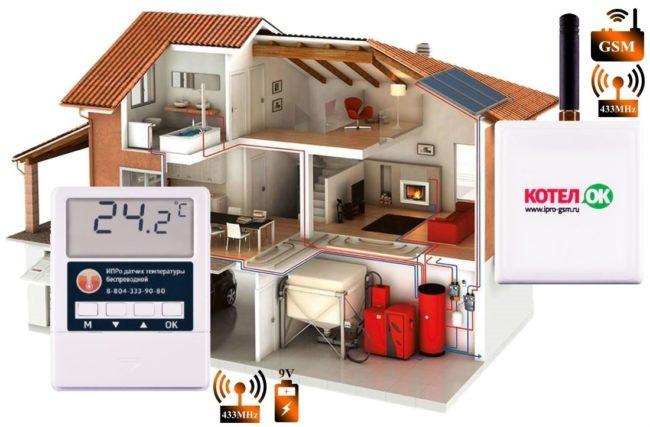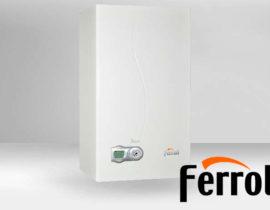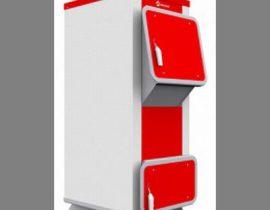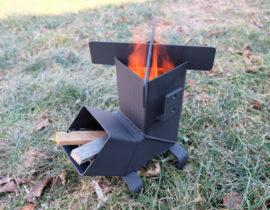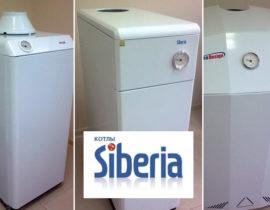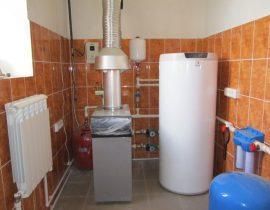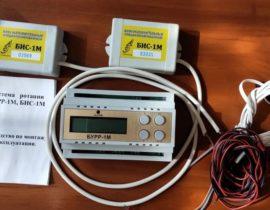If you have to leave the house for a long time or we are talking about a summer house, it is important to maintain a constant temperature of the boiler. First, it prevents the water in the system from freezing. Secondly, it heats the room to the desired level. The most common way to implement remote control of the boiler is a GSM module. Let's talk about it in more detail.
Content
- The device and principle of operation of the GSM-module for the boiler
- What boilers does it work with
- When is a module needed?
- How to choose a GSM module
- How to connect the module yourself
- The best models of GSM modules for remote control of heating boilers
- Summing up
- Video tips for managing heating boilers via a GSM module
The device and principle of operation of the GSM-module for the boiler
In fact, the GSM module is a variation of a mobile phone, since it uses the same communication protocol.
The principle of operation of the device is as follows:
- using a SIM card, the device connects to the GSM network;
- then it connects to the smartphone;
- from the gadget, you can send a signal to the device;
- after receiving the signal, the module changes the boiler settings (raises or lowers the temperature, turns it on, turns it off).
The module itself consists of the following structural elements:
- Thermostat. Controls the temperature of the boiler and sends a signal to the owner's smartphone about its change.Many models allow you to use other methods of notification (light, sound signals).
- fasteners. Base for mounting fixture. Typically designed to be mounted on a vertical wall.
- Power Supply. The module elements are not designed to work with the standard voltage of the household electrical network. Therefore, they need a power supply. Typically, the operating voltage of the instrument is 9V or 12V.
- Antenna. Allows you to receive signals in the GSM range, with the help of which the module is controlled.
- Sensor. Determines the temperature of the boiler and transmits the received information to the thermostat for further processing and notification of the owner. Most sensors are capable of operating at t from -50 about From to +99 about C. This allows you to use them in almost any environment.
- Redundant power supply. Represents a battery or accumulator. Designed in case of a power outage or power supply failure. Provides long autonomous operation of the device with full preservation of functionality.
Operating modes
Most existing device models have two modes of operation:
 Auto. The owner of the device sets the necessary settings, and the device works in accordance with them. For example, you can set the boiler to turn off when a certain temperature is reached and turn it on again after cooling down.
Auto. The owner of the device sets the necessary settings, and the device works in accordance with them. For example, you can set the boiler to turn off when a certain temperature is reached and turn it on again after cooling down.- Manual. In this case, the control is completely manual. To do this, use a smartphone.
- alarming. In fact, this is the same automatic mode. But with one caveat - the system notifies the user in case of emergency (for example, an unexpected rise in temperature above the permissible values \u200b\u200band spontaneous shutdown of the boiler).
Some models allow you to combine modes. For example, you can enable manual control of the boiler and at the same time turn on emergency notifications.
What boilers does it work with
Before buying a module, you need to find out if the heating boiler supports the connection of such a device. This support is not available in all models.
To connect the device, autonomous systems with forced circulation of the coolant (that is, equipped with a pump) are suitable. At the same time, it is necessary to rework the security system in order to prevent breakthroughs at the module connection points.
Features of operation in various types of boilers
The device has the specifics of operation in different types of heating systems:
- When used in electric boilers, voltage monitoring is possible. Also, the device can signal a short circuit.
- When used with several boilers at the same time, the device can summarize information from them. This is true when used in production or in utility rooms.
- In wood pellet boilers, the module can regulate the fuel supply to the system.
When is a module needed?
A GSM module to control the boiler is required when the owner of the house is absent for a long time, provided that it is necessary to maintain a certain temperature or turn on the heating in a timely manner.
The most common situations where this is necessary include the following:
- Long departure. The owner of the house goes on a business trip or on vacation. At the same time, it is impossible to completely turn off the heating - the system will freeze. At the same time, there is no one to control the boiler at home.
- Cottage with heating system. If a heating system is installed in the country house, then when the boiler is turned off during the cold season, it will freeze. To prevent this, you can merge the system. But then it will be impossible to come to the dacha in winter because of the cold that will be in the house. The solution to the problem is remote maintenance of a low positive temperature to prevent freezing using a GSM module.
How to choose a GSM module
When choosing a GSM module, you should pay attention to the following parameters:
- Ease of management. With a smartphone, everything is clear - the device is controlled using an application. But if the owner is at home, interaction with the device occurs differently. There are two most common control methods: physical buttons and touch screen. Models with the second option are more convenient (they show more information about the operation of the heating system). But they cost more. Of course, there are also models that are controlled exclusively from a smartphone. But you should not buy them - using such devices is not very convenient.
- Equipment. The basic delivery set of the module includes an antenna, an internal temperature sensor, fasteners and the device itself. But there are models with extended equipment. It may include external temperature sensors, gas detectors and other components. The kit is selected based on specific tasks. For example, if the goal is to ensure maximum safety, it is better to take the option with a gas sensor. And if you just need to remotely control the boiler, the minimum equipment will do.
- Number of channels. The more there are, the more users can control the device. The cheapest models have two channels. But if there are three or four households, this option is completely unsuitable.Therefore, the more people in the family, the more channels should be on the module. It should be borne in mind that multi-channel devices will cost more.
- Backup battery capacity. The larger it is, the longer the device is able to work offline. It must be borne in mind that you should not overpay for a capacious battery where it is not needed. It is relevant only in the case when in the village where the house is located, the electricity is often and for a long time cut off.
The GSM module for the boiler is the case when the quality of the device directly depends on the price. The higher the cost, the more powerful the processor (which means more settings can be set), the management is more convenient and the bundle is richer. Therefore, saving is always a compromise in relation to the comfort of using the device.
How to connect the module yourself
The algorithm for connecting the module to the boiler is always approximately the same. The model of the device does not matter.
 To connect the device, you must:
To connect the device, you must:
- de-energize the boiler;
- remove the cover;
- connect or solder the wires of the module to the boiler board in accordance with the instructions;
- install a SIM card, antenna, sensors;
- put back the boiler casing;
- turn on the module and synchronize it with your smartphone;
- restore electricity supply.
The best models of GSM modules for remote control of heating boilers
Consider several current models of devices available today for purchase.
Boiler OK 2.0
 A simple, inexpensive and reliable Russian-made model. The cost of the product varies from 5,000 to 6,500 rubles.
A simple, inexpensive and reliable Russian-made model. The cost of the product varies from 5,000 to 6,500 rubles.
Consists of the following components:
- GSM unit with antenna;
- control Panel;
- sensor.
The control panel has a wide monochrome display and four setting buttons.A good GSM antenna provides good signal quality.
The main disadvantage of the device:
- control via SMS commands (app not available). This is not very convenient.
The main advantage of KotelOK 2.0:
- the ability to fine-tune the temperature of the heating system. It can be changed up to 0.1 about FROM.
Telemetry 3
 Compact and convenient GSM-module. Has the big and most informative monochrome liquid crystal display. Management is carried out using three physical buttons, which are located under the screen.
Compact and convenient GSM-module. Has the big and most informative monochrome liquid crystal display. Management is carried out using three physical buttons, which are located under the screen.
- The main advantage of the device
Versatility. It can be connected not only to the boiler, but also to any other device (for example, an air conditioner).
- Minus
Lack of a complete external antenna. Of course, third-party installation is possible. But these are additional costs. Which are completely inappropriate given the high price of the device (about 9,000 - 10,000 rubles).
Optima-1 Heat monitor
 Simple, reliable and easy to use device. It consists of a pair of thermostat - GSM-module. Able to work with several boilers at the same time. It is also possible to connect to an alarm system.
Simple, reliable and easy to use device. It consists of a pair of thermostat - GSM-module. Able to work with several boilers at the same time. It is also possible to connect to an alarm system.
Programming for the next seven days is provided for automatic use. There is frost protection, which allows the model to be used in conditions of negative temperatures.
Due to the presence of a remote antenna in the kit, stable signal reception from the owner’s smartphone is ensured with almost no interruptions.
- The main disadvantage of the device
Insufficiently informative interface. There is no display here. Instead, indicator LEDs are used. It is clear that it is difficult to reflect all the necessary information with their help.
The cost of the device is from 8,500 to 9,000 rubles.
Summing up
GSM-module is a device for remote control of a heating boiler. It allows you to adjust the temperature, turn the system on and off at the right time. The device is suitable for those who are away from home for a long time. Different models have different functionality. Usually, the cheaper the device, the smaller the set of functions and the poorer the bundle. A suitable option is selected based on the tasks of use.
Video tips for managing heating boilers via a GSM module






